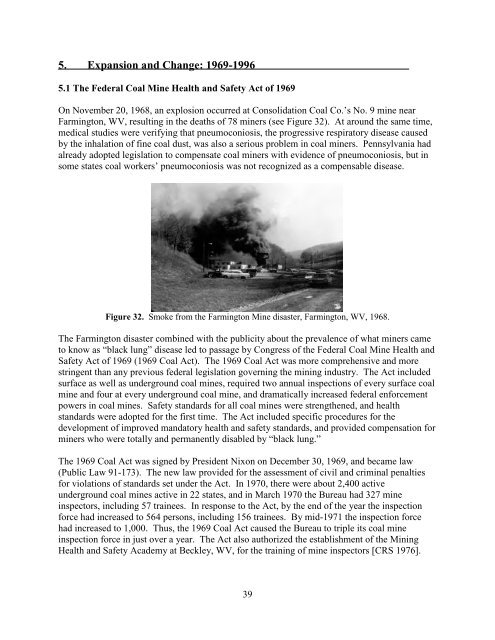One Hundred Years of Federal Mining Safety and Health Research
One Hundred Years of Federal Mining Safety and Health Research
One Hundred Years of Federal Mining Safety and Health Research
- No tags were found...
Create successful ePaper yourself
Turn your PDF publications into a flip-book with our unique Google optimized e-Paper software.
5. Expansion <strong>and</strong> Change: 1969-1996<br />
5.1 The <strong>Federal</strong> Coal Mine <strong>Health</strong> <strong>and</strong> <strong>Safety</strong> Act <strong>of</strong> 1969<br />
On November 20, 1968, an explosion occurred at Consolidation Coal Co.’s No. 9 mine near<br />
Farmington, WV, resulting in the deaths <strong>of</strong> 78 miners (see Figure 32). At around the same time,<br />
medical studies were verifying that pneumoconiosis, the progressive respiratory disease caused<br />
by the inhalation <strong>of</strong> fine coal dust, was also a serious problem in coal miners. Pennsylvania had<br />
already adopted legislation to compensate coal miners with evidence <strong>of</strong> pneumoconiosis, but in<br />
some states coal workers’ pneumoconiosis was not recognized as a compensable disease.<br />
Figure 32. Smoke from the Farmington Mine disaster, Farmington, WV, 1968.<br />
The Farmington disaster combined with the publicity about the prevalence <strong>of</strong> what miners came<br />
to know as “black lung” disease led to passage by Congress <strong>of</strong> the <strong>Federal</strong> Coal Mine <strong>Health</strong> <strong>and</strong><br />
<strong>Safety</strong> Act <strong>of</strong> 1969 (1969 Coal Act). The 1969 Coal Act was more comprehensive <strong>and</strong> more<br />
stringent than any previous federal legislation governing the mining industry. The Act included<br />
surface as well as underground coal mines, required two annual inspections <strong>of</strong> every surface coal<br />
mine <strong>and</strong> four at every underground coal mine, <strong>and</strong> dramatically increased federal enforcement<br />
powers in coal mines. <strong>Safety</strong> st<strong>and</strong>ards for all coal mines were strengthened, <strong>and</strong> health<br />
st<strong>and</strong>ards were adopted for the first time. The Act included specific procedures for the<br />
development <strong>of</strong> improved m<strong>and</strong>atory health <strong>and</strong> safety st<strong>and</strong>ards, <strong>and</strong> provided compensation for<br />
miners who were totally <strong>and</strong> permanently disabled by “black lung.”<br />
The 1969 Coal Act was signed by President Nixon on December 30, 1969, <strong>and</strong> became law<br />
(Public Law 91-173). The new law provided for the assessment <strong>of</strong> civil <strong>and</strong> criminal penalties<br />
for violations <strong>of</strong> st<strong>and</strong>ards set under the Act. In 1970, there were about 2,400 active<br />
underground coal mines active in 22 states, <strong>and</strong> in March 1970 the Bureau had 327 mine<br />
inspectors, including 57 trainees. In response to the Act, by the end <strong>of</strong> the year the inspection<br />
force had increased to 564 persons, including 156 trainees. By mid-1971 the inspection force<br />
had increased to 1,000. Thus, the 1969 Coal Act caused the Bureau to triple its coal mine<br />
inspection force in just over a year. The Act also authorized the establishment <strong>of</strong> the <strong>Mining</strong><br />
<strong>Health</strong> <strong>and</strong> <strong>Safety</strong> Academy at Beckley, WV, for the training <strong>of</strong> mine inspectors [CRS 1976].<br />
39
















